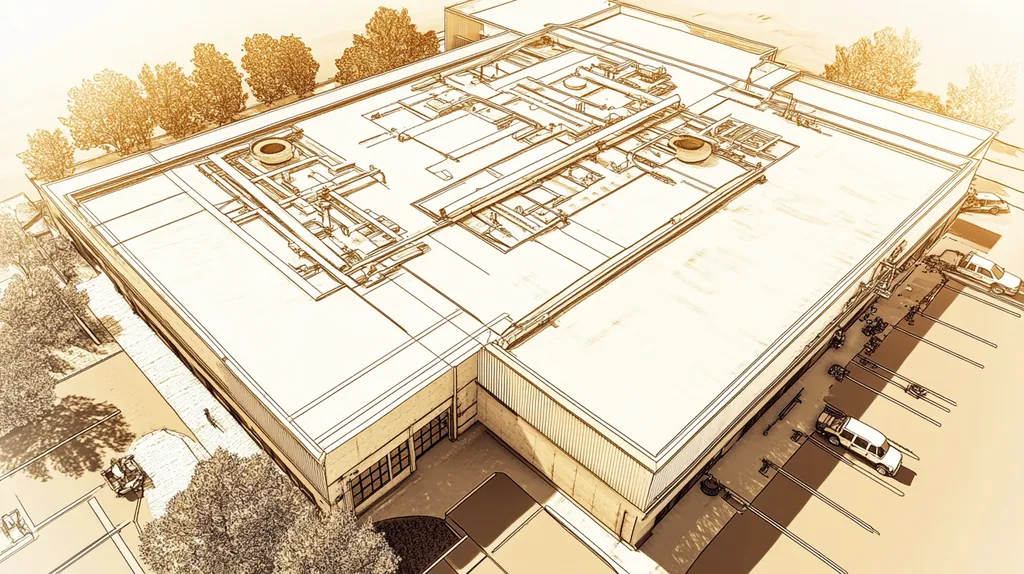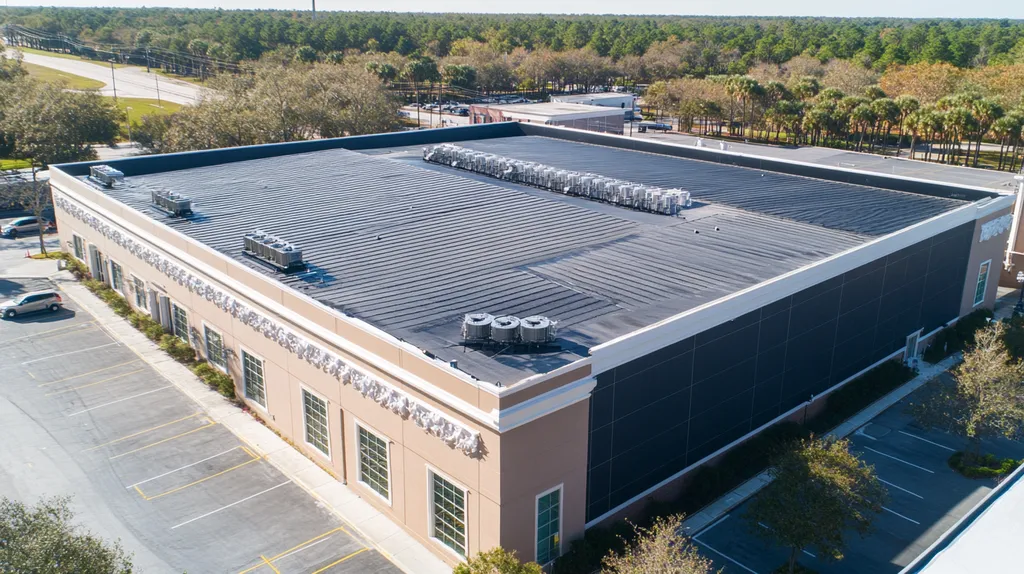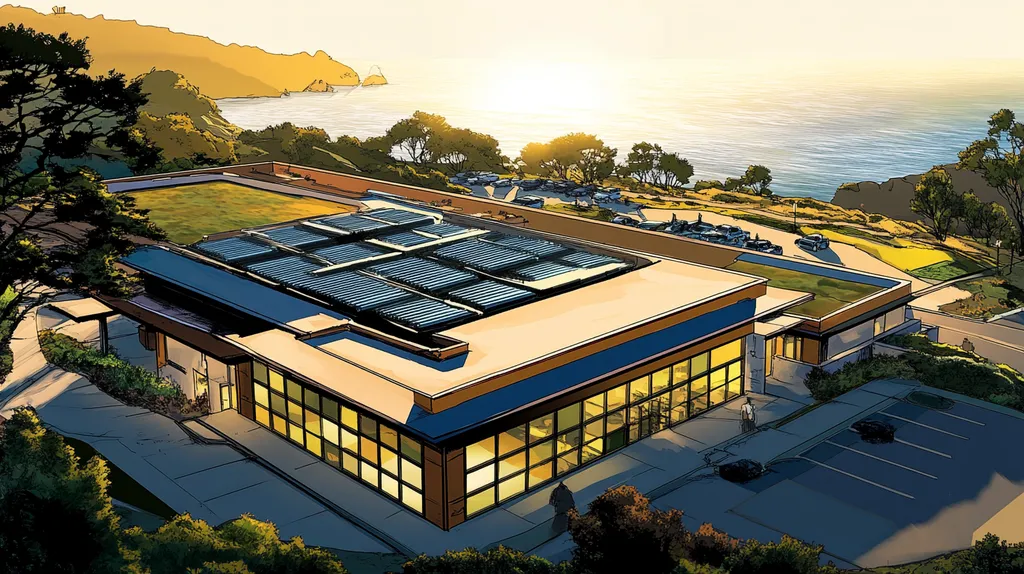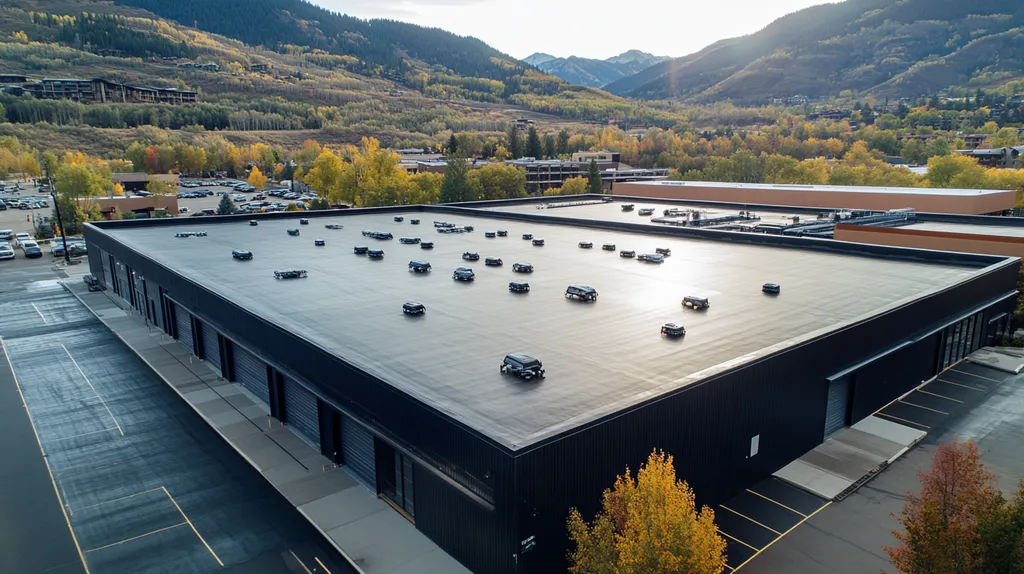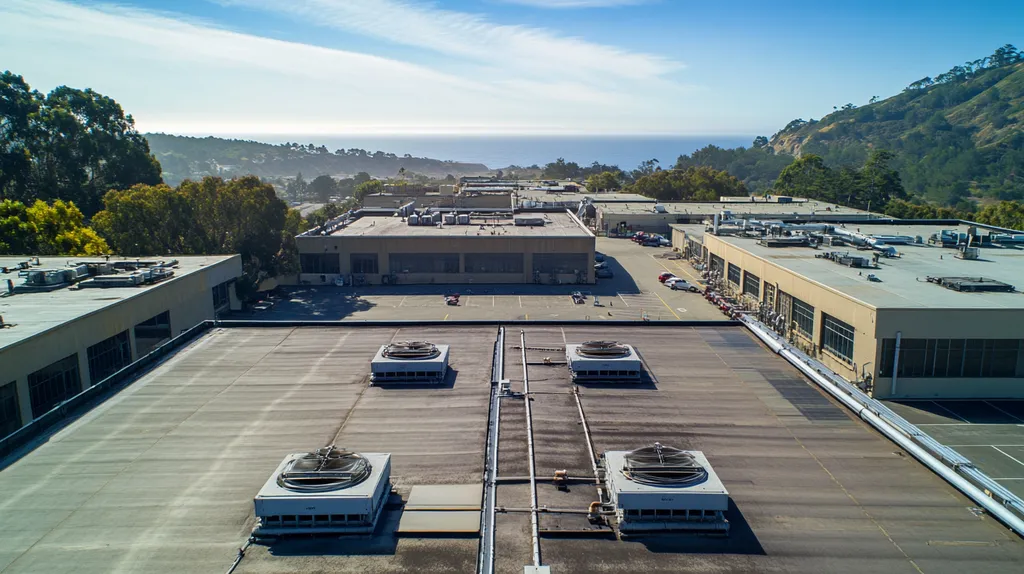With commercial roof replacements averaging $250,000 to over $1 million, choosing the wrong financing approach can cripple a business’s cash flow or lead to catastrophic property damage. Industry data shows that 72% of failed roofing projects stem from improper financial planning rather than technical issues.
Today’s property owners face an increasingly complex landscape of financing options, from traditional bank loans to specialized contractor programs and tax-incentivized solutions. Understanding these choices – and their long-term implications – has become crucial for protecting both facility assets and bottom-line performance.
This comprehensive guide examines six critical aspects of commercial roof financing, from fundamental concepts through optimization strategies, providing property owners with actionable insights for making informed financing decisions.
SECTION 1: FUNDAMENTAL CONCEPTS
Commercial roof financing decisions can make or break a project’s success. Recent industry data shows that 72% of failed roofing projects stem from improper financial planning rather than technical issues. With commercial roof replacements typically ranging from $250,000 to over $1 million, choosing the right financing approach becomes crucial for protecting both the property and the bottom line.
Overview of Commercial Roof Financing Options
Term loans provide stable, predictable repayment schedules with upfront capital for large roofing projects. This traditional option offers clear budgeting parameters and typically features fixed interest rates.
Revenue-based financing presents a more flexible alternative, adjusting payment schedules based on monthly business income. This approach proves particularly valuable for businesses with seasonal revenue fluctuations.
Commercial real estate loans can fund comprehensive roofing projects as part of larger facility improvements, though they typically require substantial collateral and strong credit scores. (source: Biz2Credit)
Insurance-backed financing options may cover partial or full replacement costs when roof damage results from covered events. This option often requires minimal upfront capital but depends on policy terms and claim approval.
Key Financial Terms and Credit Requirements
Credit requirements vary significantly across financing options. Most commercial lenders require a minimum credit score of 675, though some specialized roofing financiers may accept scores as low as 600.
Debt service coverage ratio (DSCR) plays a crucial role in loan approval. Lenders typically expect a minimum DSCR of 1.25, meaning the business generates 25% more income than needed for debt payments.
Annual percentage rate (APR) represents the true cost of financing, including interest and fees. Commercial roof financing APRs typically range from 5% to 15%, depending on creditworthiness and term length.
Loan-to-value (LTV) ratios influence both approval odds and interest rates. Most lenders cap commercial roof financing at 75-80% LTV, requiring property owners to provide the remaining funds.
Impact of Financing on Project Budgeting and Cash Flow
Financing choices directly affect monthly cash flow and project timeline flexibility. Traditional loans require fixed monthly payments regardless of business performance, while revenue-based options adjust with income fluctuations.
Project scope often expands or contracts based on available financing. Properties securing lower interest rates can often afford higher-quality materials or more comprehensive solutions within the same monthly payment structure.
Payment timing impacts both contractor relationships and project scheduling. Some financing options allow for milestone-based disbursements, aligning payments with project completion phases.
Long-term maintenance costs vary significantly based on initial financing decisions. Higher upfront investment in quality materials, enabled by favorable financing, typically reduces ongoing maintenance expenses over the roof’s lifespan.
SECTION 2: SYSTEM COMPONENTS
Commercial roofing projects require careful coordination between multiple system components to achieve optimal results. With project costs typically ranging from $250,000 to over $1 million, understanding these components becomes essential for protecting valuable property assets. Recent industry data shows that projects lacking proper alignment between financing, contractor expertise, and risk assessment are 3 times more likely to experience costly delays or complications.
Types of Commercial Roof Projects Eligible for Financing
Complete roof replacements typically qualify for comprehensive financing packages, offering terms ranging from 5 to 20 years depending on the scope and materials used. These projects often include removal of existing materials, deck repair, and full system installation.
Partial replacements and major repairs may qualify for shorter-term financing options, particularly when addressing urgent structural concerns or water infiltration issues. These projects usually focus on specific sections or systems requiring immediate attention.
Energy-efficient upgrades and green roof installations can access specialized financing programs through government incentives and environmental initiatives. These projects often qualify for additional tax benefits or reduced interest rates due to their sustainability focus.
Preventive maintenance programs and coating applications may qualify for revolving credit lines or shorter-term loans. These projects help extend roof life while spreading costs over manageable payment periods.
Role of Contractors and Lenders in Financing Agreements
Qualified contractors serve as critical intermediaries between property owners and financial institutions. They provide detailed project specifications, timeline estimates, and cost breakdowns that lenders require for financing approval.
Lenders evaluate both the contractor’s track record and the property owner’s financial stability when considering financing applications. They assess factors like contractor licensing, insurance coverage, and previous project completion rates.
Many established roofing contractors maintain relationships with multiple financing partners. This network allows them to match property owners with lenders offering the most advantageous terms for specific project types.
Professional contractors also help coordinate payment schedules that align with project milestones. This ensures proper fund disbursement and maintains steady project progress.
Structural and Financial Risk Assessment
Comprehensive structural evaluations must precede any financing application. These assessments identify potential complications that could affect project costs or timeline, including deck condition, drainage systems, and existing material compatibility.
Financial risk evaluation examines both immediate project costs and long-term maintenance implications. This includes analyzing energy savings potential, warranty coverage, and expected service life of proposed solutions.
Property value impact plays a crucial role in risk assessment. Lenders consider how the roofing investment will affect overall building worth and future resale potential.
Risk mitigation strategies often include phased implementation plans. These allow property owners to spread costs over time while addressing critical areas first, reducing both financial and operational risks.
SECTION 3: IMPLEMENTATION METHODS
Commercial roof financing requires strategic implementation to protect both immediate and long-term business interests. Recent data shows that over 65% of roofing projects face delays or cost overruns due to misaligned financing structures. With projects routinely exceeding $500,000, choosing and implementing the right financing method becomes critical for maintaining both property value and operational continuity.
Securing Bank Loans for Roofing Projects
Traditional bank loans offer structured financing solutions with predictable repayment schedules and typically lower interest rates than alternative funding sources. Term loans provide stable, predictable repayment schedules with upfront capital for large roofing projects. (source: Biz2Credit)
Successful loan applications require comprehensive documentation, including detailed project specifications, contractor credentials, and projected ROI calculations. Most lenders expect to see multiple contractor bids and detailed scope-of-work documents.
Property owners should prepare for extensive underwriting processes, which typically evaluate both the building’s current condition and post-project value potential. This evaluation helps secure more favorable terms and higher approval rates.
Construction-specific loans often offer advantages over general commercial loans, including flexible disbursement schedules that align with project milestones. These specialized products can reduce carrying costs during the construction phase.
Utilizing Lines of Credit and Equity Financing
Commercial lines of credit provide flexible access to funds, allowing property owners to draw only what’s needed as project phases progress. This approach helps optimize cash flow management and reduce interest expenses.
Equipment financing lines specifically designed for roofing materials can offer lower rates than general business credit lines. These specialized products often include tax advantages and may allow for longer repayment terms.
Building equity loans leverage existing property value to fund improvements, potentially offering lower interest rates than unsecured financing options. This method proves particularly valuable for properties with significant accumulated equity.
Working capital lines can supplement primary financing, providing buffer funding for unexpected expenses or scope changes during project execution. These secondary funding sources help prevent costly project delays.
Contractor-Provided Financing Programs and Partnerships
Many commercial roofing contractors now offer direct financing options through partnerships with specialized lenders. These programs often feature streamlined approval processes and industry-specific terms.
Manufacturer-backed financing programs can provide competitive rates when using specific roofing systems. These arrangements frequently include extended warranties and maintenance packages within the financing structure.
Joint venture financing options allow property owners to share project costs with contractors, reducing initial capital requirements. This approach can align contractor incentives with long-term project success.
Performance-based financing structures tie payment terms to achieved energy savings or other measurable improvements. This model helps justify larger initial investments by linking costs to documented benefits.
SECTION 4: MAINTENANCE REQUIREMENTS
The financial implications of commercial roof maintenance extend far beyond routine upkeep. Industry data reveals that deferring maintenance typically increases repair costs by 500% over a roof’s lifetime. For a typical 50,000-square-foot commercial roof, proper maintenance planning can mean the difference between manageable annual expenses and catastrophic six-figure emergency replacements. Understanding these maintenance requirements and their associated financing options is crucial for protecting both the physical asset and bottom line.
Financing Maintenance vs. Replacement Costs
Term loans provide stable, predictable funding for both scheduled maintenance and full replacement projects, helping property owners maintain consistent cash flow while protecting their roofing assets. These financing solutions can cover comprehensive maintenance programs or complete system replacements, with terms tailored to the project scope. (source: Biz2Credit)
Regular maintenance programs typically cost 1-2% of replacement value annually, while emergency replacements can demand 15-20 times that amount. This stark contrast highlights the importance of securing appropriate financing for preventive care.
Maintenance financing packages often include warranty extensions and performance guarantees, providing additional value beyond the immediate repair work. These programs help protect the initial roofing investment while reducing long-term ownership costs.
Property owners can leverage maintenance financing to spread costs over time, avoiding large capital expenditures while ensuring consistent roof performance. This approach helps maintain stable operating budgets and predictable expenses.
Budgeting for Scheduled and Emergency Roof Repairs
Effective budgeting requires allocation for both planned maintenance and emergency response funds. Industry standards suggest maintaining emergency reserves equal to 10% of the roof’s replacement cost.
Monthly payment structures help normalize maintenance expenses across fiscal periods. This approach prevents budget spikes while ensuring adequate funding for routine inspections and repairs.
Emergency repair financing options should be established before urgent situations arise. Having pre-approved credit lines or dedicated repair funds prevents costly delays when immediate action becomes necessary.
Performance-based maintenance budgets tie expenditures to specific outcomes, helping justify ongoing investments. This approach allows property owners to demonstrate clear returns on maintenance spending.
Leveraging Financing for Preventive Maintenance Programs
Preventive maintenance programs require consistent funding to deliver optimal results. Structured financing packages help ensure these critical programs receive adequate resources without straining operational budgets.
Multi-year maintenance contracts often qualify for specialized financing terms, including lower interest rates and flexible payment schedules. These arrangements help property owners commit to comprehensive care programs.
Financing preventive maintenance through dedicated credit lines provides flexibility for addressing emerging issues before they become major problems. This proactive approach typically reduces total ownership costs by 30-40% over the roof’s lifespan.
Integration of maintenance financing with capital improvement plans helps optimize overall facility management. This coordinated approach ensures roofing investments align with broader property objectives.
SECTION 5: PERFORMANCE METRICS
Performance metrics drive critical decisions in commercial roof financing. Recent industry analysis shows that properly financed roofing projects can reduce total operating costs by up to 40% over a 20-year period. Yet many property owners struggle to accurately measure and track these financial benefits, leading to suboptimal financing choices that impact both immediate cash flow and long-term property value.
Measuring Financial ROI of Roof Financing Plans
Effective ROI calculation requires analyzing both direct and indirect financial impacts. Initial costs, energy savings, maintenance reduction, and tax implications all factor into the complete financial picture.
Property owners must evaluate financing costs against projected operational savings. A higher-quality roof system financed at favorable terms often delivers superior returns compared to budget solutions with higher maintenance needs.
Loan programs from specialized lenders offer fixed payment structures that simplify ROI calculations. These programs typically feature competitive interest rates and tax-deductible interest payments that enhance overall returns. (source: Tema Roofing Services)
Energy efficiency improvements often generate the most measurable returns. Modern roofing systems can reduce HVAC costs by 15-30%, creating substantial monthly savings that offset financing expenses.
Assessing Impact on Building Value and Insurance
Quality roofing systems directly influence property valuation metrics. Commercial appraisers typically add 70% of roof improvement costs to building value, while energy-efficient systems may contribute even more.
Insurance premiums often decrease with modern roofing installations. Many carriers offer premium reductions of 5-15% for impact-resistant or weather-resistant roof systems.
Building certification programs like LEED and Energy Star consider roof performance in their ratings. Higher ratings typically correlate with increased property values and reduced operating costs.
Warranty coverage affects both insurance requirements and building value. Extended warranties secured through financing packages can enhance property marketability and reduce long-term risk exposure.
Tracking Cost Savings Through Financing Incentives
Federal, state, and local incentives can significantly reduce net project costs. Tax deductions for energy efficiency improvements often range from $0.30 to $1.80 per square foot.
Utility company rebates frequently offset 15-30% of energy-efficient roofing costs. These incentives may be factored into financing packages to reduce initial capital requirements.
Performance tracking systems help document energy savings for incentive qualification. Modern monitoring solutions can precisely measure efficiency gains and validate tax credit eligibility.
Financing packages that incorporate available incentives typically deliver superior returns. Careful documentation of savings helps justify premium materials and comprehensive solutions that maximize long-term benefits.
SECTION 6: OPTIMIZATION STRATEGIES
Optimizing commercial roof financing can mean the difference between project success and financial strain. Industry data shows that poorly structured financing leads to 45% higher lifetime costs, while well-optimized plans can reduce total expenditure by up to 30%. For a typical 50,000-square-foot commercial roof project, this difference can exceed $200,000 over the installation’s lifespan. Strategic optimization of financing options, tax incentives, and vendor relationships has become essential for protecting both immediate cash flow and long-term property value.
Tax Credits and Incentives for Roof Financing
Tax incentives represent a critical yet often overlooked component of roof financing optimization. Section 179 deductions can allow property owners to write off up to $1.08 million in qualifying roof improvements during the installation year, significantly reducing the effective project cost.
Energy-efficient roofing installations may qualify for additional federal tax credits worth up to 10% of material costs. These incentives can substantially reduce the net project expense while promoting sustainable building practices.
State and local governments frequently offer additional tax benefits for commercial roof improvements. These programs often focus on energy efficiency upgrades and can provide rebates ranging from $0.20 to $0.50 per square foot.
Property owners should carefully document all efficiency improvements and maintain detailed records of associated costs. This documentation proves essential for maximizing available tax benefits and ensuring compliance with incentive program requirements.
Combining Financing Options for Maximum Flexibility
Revenue-based financing aligns repayments with monthly revenue, offering flexible terms for seasonal businesses. Term loans and commercial real estate loans provide stable funding sources for major roofing investments, with predictable payment schedules that facilitate long-term planning. (source: Biz2Credit)
Strategic combination of short-term and long-term financing options can optimize cash flow management. This approach allows property owners to balance immediate project needs with sustainable payment structures.
Equipment financing lines specifically for roofing materials can complement traditional loans. These specialized products often feature lower interest rates and may include maintenance coverage within the financing package.
Working capital lines serve as valuable supplements to primary financing, providing buffer funding for unexpected scope changes or material cost increases during project execution.
Best Practices for Financial Planning and Vendor Negotiation
Comprehensive financial planning should begin at least six months before project initiation. This timeline allows for thorough evaluation of financing options, tax implications, and potential vendor partnerships.
Multiple contractor bids should be evaluated not just on price, but on financing flexibility and payment terms. Leading vendors often maintain relationships with specialized lenders who understand roofing project requirements.
Payment schedules should align with project milestones and business cash flow patterns. This coordination helps prevent financial strain while ensuring steady project progress.
Performance guarantees and warranty terms deserve careful consideration during negotiations. These elements can significantly impact long-term costs and should be factored into financing decisions.
The Bottom Line
With commercial roof projects routinely exceeding $1 million, choosing the right financing strategy has become a critical business decision that impacts both immediate operations and long-term property value.
Industry data shows that optimized financing approaches can reduce total project costs by up to 30% through strategic use of tax incentives, flexible payment structures, and preventive maintenance programs.
Property owners who leverage multiple financing options while carefully documenting efficiency improvements position themselves to maximize available tax benefits and minimize long-term expenses.
Success requires early planning, thorough evaluation of financing alternatives, and strategic alignment between funding sources, contractor capabilities, and business objectives to protect both facility assets and bottom-line performance.
FREQUENTLY ASKED QUESTIONS
Q. What are the financing options for a commercial roof project?
A. Financing options include term loans, revenue-based financing, commercial real estate loans, and insurance-backed financing. Term loans offer predictable repayments, while revenue-based options adjust based on income. Each method varies in risk and flexibility, depending on the project’s specific needs.
Q. How do I align financing for my industrial roof project?
A. It’s crucial to coordinate financing with contractors and assess project requirements beforehand. Proper alignment helps ensure funding matches project scope and timelines, reducing delays and cost overruns. Engaging experienced contractors can streamline communication between you and lenders for better financing terms.
Q. What are the key requirements for financing a commercial roof?
A. Financing typically requires a solid credit score, a minimum debt service coverage ratio, and sufficient collateral. Lenders may also expect detailed project proposals highlighting costs and expected outcomes. Meeting these requirements eases the approval process and helps secure favorable loan terms.
Q. How can I budget for emergency repairs on my commercial roof?
A. Effective budgeting should allocate funds for both expected and unexpected repairs. Industry recommendations suggest maintaining reserves equal to 10% of the roof’s replacement cost. Additionally, establishing credit lines for emergency expenses can ensure prompt response to urgent repairs, minimizing damage costs.
Q. What tax benefits are available for financing a commercial roof?
A. Tax benefits may include deductions for energy-efficient installations and potential rebates from local governments. Documenting all associated costs and improvements is crucial to maximize these benefits. Programs like Section 179 can dramatically reduce the overall financing burden by allowing significant deductions.
Q. How critical is ongoing maintenance financing for roof longevity?
A. Ongoing maintenance financing is vital for extending roof lifespan and avoiding costly repairs. Regular upkeep generally costs far less than emergency replacements. Establishing a maintenance fund ensures periodic inspections and timely repairs, which help maintain the roof’s condition and protect your investment.
Q. What performance metrics should I track for my commercial roof financing?
A. Track metrics such as energy savings, maintenance costs, and roofing durability. These factors will help determine the return on investment and inform future financing decisions. Accurate performance tracking identifies areas for improvement and reinforces the value of your roofing investments.

